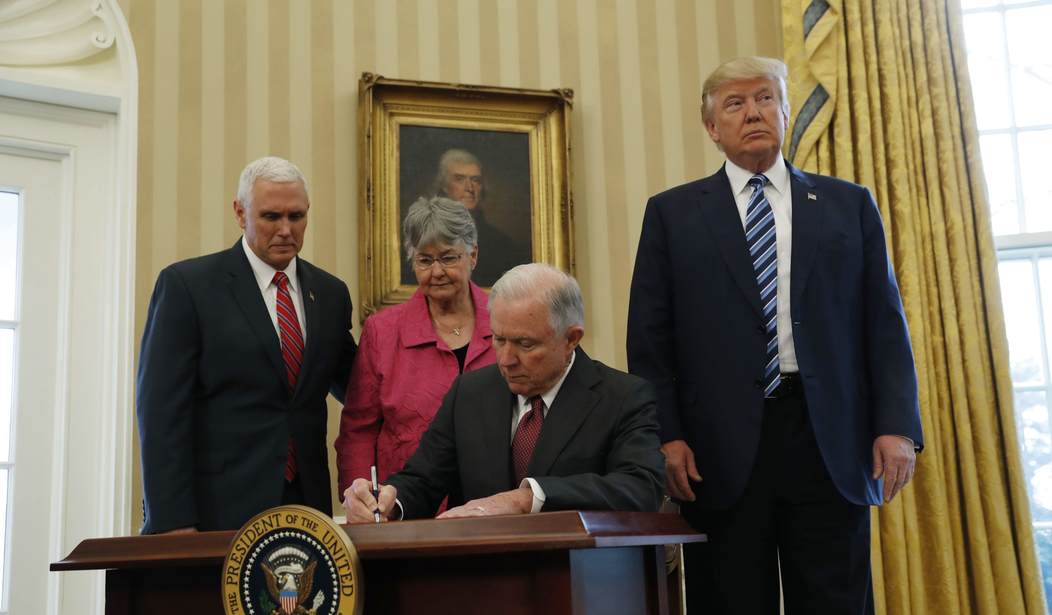WASHINGTON — President Trump issued a trio of law-and-order executive orders today, with one calling for potential new crime definitions and mandatory minimum sentences for violence against law enforcement.
One order establishes a Task Force on Crime Reduction and Public Safety, without detail on the composition of the panel. The taks force is supposed to “exchange information and ideas among its members that will be useful in developing strategies to reduce crime, including, in particular, illegal immigration, drug trafficking, and violent crime” and “based on that exchange of information and ideas, develop strategies to reduce crime.”
The panel is also charged with “identify deficiencies in existing laws that have made them less effective in reducing crime” to “propose new legislation that could be enacted to improve public safety and reduce crime.”
The order states the task force must submit a report to the president within a year.
Trump’s executive order on preventing violence against federal, state, tribal and local law enforcement officers directs Attorney General Jeff Sessions to “develop a strategy for the department’s use of existing federal laws to prosecute individuals who commit or attempt to commit crimes of violence” against cops and to “advance adequate multi-jurisdiction prosecution efforts.”
After a review of existing laws, the order directs Sessions “to make recommendations to the president for legislation to address the protection and safety of federal, state, tribal, and local law enforcement officers, including, if warranted, legislation defining new crimes of violence and establishing new mandatory minimum sentences for existing crimes of violence.”
Trump wants the attorney general to “coordinate with other federal agencies to develop an executive branch strategy” and evaluate grant funding for law enforcement safety.
The final executive order focuses on transnational criminal organizations including drug cartels, gangs and human smuggling operations, and calls for “a comprehensive and decisive approach …to dismantle these organized crime syndicates and restore safety for the American people.”
It directs federal law enforcement agencies to “give a high priority and devote sufficient resources to efforts to identify, interdict, disrupt, and dismantle transnational criminal organizations and subsidiary organizations, including through the investigation, apprehension, and prosecution of members of such organizations, the extradition of members of such organizations to face justice in the United States and, where appropriate and to the extent permitted by law, the swift removal from the United States of foreign nationals who are members of such organizations.”
The order calls for greater cooperation among agencies to “pursue and support additional efforts to prevent the operational success of transnational criminal organizations and subsidiary organizations within and beyond the United States, to include prosecution of ancillary criminal offenses, such as immigration fraud and visa fraud, and the seizure of the implements of such organizations and forfeiture of the proceeds of their criminal activity.”
It forms a Threat Mitigation Working Group among the secretary of State, the attorney general, the secretary of Homeland Security, and the director of national intelligence to, among other assessment and review duties, “prevent foreign members of these organizations or their associates from obtaining entry into the United States and from exploiting the United States immigration system.”
Jeffery Robinson, deputy legal director of the American Civil Liberties Union, said Trump “intends to build task forces to investigate and stop national trends that don’t exist.”
“We have seen historic lows in the country’s crime rate and a downward trend in killings against police officers since the 1980s,” Robinson said. “The president not only doesn’t acknowledge these facts about our nation’s safety, he persists in ignoring the all-too-real deaths of black and brown people at the hands of law enforcement.”
Robinson acknowledged “there are some cities that have had recent rises in violent crime, and they deserve help.”
“And every locality in America wants to further reduce crime and violence,” he added. “But task forces premised on misinformation, and looking in the wrong places for the wrong problems, are not the answer.”
At his swearing-in today, Sessions declared “we have a crime problem.”
“I wish the rise that we’re seeing in crime in America today were some sort of aberration or a blip,” Sessions said. “My best judgment, having been involved in criminal law enforcement for many years, is that this is a dangerous, permanent trend. It places the health and safety of the American people are risk.”
The FBI’s preliminary crime report for 2016, covering the first six months of last year, showed a 5.3 percent rise in violent crimes — aggravated assaults saw the largest jump, at 6.5 percent — and a 0.6 percent decrease in property crimes. Homicides saw the greatest jumps last year in cities over a million people and in towns with population of less than 10,000.
Murder rates peaked in the 1990s and have steadily fallen until a slight climb again beginning in 2014.
Trump erroneously said at a Tuesday meeting with sheriffs that “the murder rate is the highest it’s been in, I guess, from 45 to 47 years.” Advisor Kellyanne Conway told CNN on Wednesday that she thought Trump might be “relying upon data perhaps for a particular area — I don’t know who gave him that data.”









Join the conversation as a VIP Member